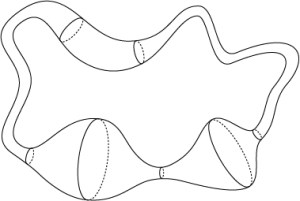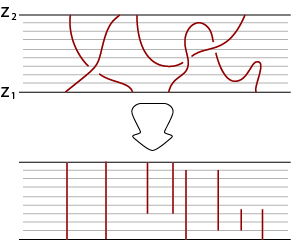Recently I came across a paper by John Pardon – a senior undergrad here at Princeton; in which he answered a question by Gromov regarding “knot distortion”. I found the paper being pretty cool, hence I wish to highlight the ideas here and perhaps give a more pictorial exposition.
This version is a bit different from one in the paper and is the improved version he had after taking some suggestions from professor Gabai. (and the bound was improved to a linear one)
Definition: Given a rectifiable Jordan curve , the distortion of
is defined as
.
i.e. the maximum ratio between distance on the curve and the distance after embedding. Indeed one should think of this as measuring how much the embedding ‘distort’ the metric.
Given knot , define the distortion of
to be the infimum of distortion over all possible embedding of
:
It was (somewhat surprisingly) an open problem whether there exists knots with arbitrarily large distortion.
Question: (Gromov ’83) Does there exist a sequence of knots where
?
Now comes the main result in the paper: (In fact he proved a more general version with knots on genus surfaces, for simplicity of notation I would focus only on torus knots)
Theorem: (Pardon) For the torus knot , we have
.
To prove this, let’s make a few observations first:
First, fix a standard embedding of in
(say the surface obtained by rotating the unit circle centered at
around the
-axis:
and we shall consider the knot that evenly warps around the standard torus the ‘standard knot’ (here’s what the ‘standard
knot looks like:
By definition, an ’embedding of the knot’, is a homeomorphism that carries the standard
to the ‘distorted knot’. Hence the knot will lie on the image of the torus (perhaps badly distorted):
For the rest of the post, we denote by
and
by
, w.l.o.g. we also suppose
.
Definition: A set is inessential if it contains no homotopically non-trivial loop on
.
Some important facts:
Fact 1: Any homotopically non-trivial loop on that bounds a disc disjoint from
intersects
at least
times. (hence the same holds for the embedded copy
).
As an example, here’s what happens to the two generators of (they have at least
and
intersections with
respectively:
From there we should expect all loops to have at least that many intersections.
Fact 2: For any curve and any cylinder set
where
is in the
-plane, let
we have:
i.e. The length of a curve in the cylinder set is at least the integral over -axis of the intersection number with the level-discs.
This is merely saying the curve is longer than its ‘vertical variation’:
Similarly, by considering variation in the radial direction, we also have
Proof of the theorem
Now suppose , we find an embedding
with
.
For any point , let
is inessential
i.e. one should consider as the smallest radius around
so that the whole ‘genus’ of
lies in
.
It’s easy to see that is a positive Lipschitz function on
that blows up at infinity. Hence the minimum value is achieved. Pick
where
is minimized.
Rescale the whole so that
is at the origin and
.
Since (and note distortion is invariant under scaling), we have
Hence by fact 2,
i.e. There exists where the intersection number is less or equal to the average. i.e.
We will drive a contradiction by showing there exists with
.
Let , since
By fact 2, there exists s.t.
. As in the pervious post, we call
a ‘neck’ and the solid upper and lower ‘hemispheres’ separated by the neck are
.
Claim: One of is inessential.
Proof: We now construct a ‘cutting homotopy’ of the sphere
:
i.e. for each is a sphere; at
it splits to two spheres. (the space between the upper and lower halves is only there for easier visualization)
Note that during the whole process the intersection number is monotonically increasing. Since
, it increases no more than
.
Observe that under such ‘cutting homotopy’, is inessential then
is also inessential. (to ‘cut through the genus’ requires at least
many intersections at some stage of the cutting process, but we have less than
many interesections)
Since is disconnected, the ‘genus’ can only lie in one of the spheres, we have one of
is inessential. Establishes the claim.
We now apply the process again to the ‘essential’ hemisphere to find a neck in the direction, i.e.cutting the hemisphere in half in
direction, then the
-direction:
The last cutting homotopy has at most many intersections, hence has inessential complement.
Hence at the end we have an approximate ball with each side having length at most
, this shape certainly lies inside some ball of radius
.
Let the center of the -ball be
. Since the complement of the
ball intersects
in an inessential set, we have
is inessential. i.e.
Contradiction.










Hi
all these are very interesting but is there any way for the pictures to show up aswell?
It seems almost none of the pictures in this blog show up.
thanks
LikeLike
Oh! It would completely kill the blog if pictures do not show up >.< they are the main content!
But they always show up fine here…most people seem to have no problem viewing them but there are a couple of cases which people can't see the pictures…I have no idea why… (maybe try a different operating system or wait longer?)
LikeLike
A friend just e-mailed me regarding this problem. He figured out that it’s due to browsers that does not support web2.0. My guess is that you are using IE? If so, switching to chrome or just about any other browser would solve the problem.
Thanks for your interest in the blog! ^^
LikeLike
[…] Cutting the Knot […]
LikeLike
Hi!
Sorry, I do not understand this. Your claim was: one part of the sphere has inessential intersection with T^2. But why the second one must have essential intersection?
For example, you can draw the following curve on the sphere: 1) the greenwich meridian from the S.P to N.P, 2) the North half of the 90-th meridian, then 3) the chord of the sphere from (0,90) to (0,-90), and 4) the South half of the -90-th meridian. The boundary of a little neighborhood of our curve is a torus. It seems to me it has inessentional intersections with both semispheres, but essentional one with the sphere.
LikeLike
sure and INESSENTIONAL one with the sphere
LikeLike
Thanks for the comment~
The example you gave is in fact a quite insightful one, as you have observed, the above example has inessential intersection with the complement of the ball (earth); it’s intersection with both the solid northern and southern hemispheres are inessential.
That’s why we need to first “cut through the middle plate and make sure the torus has inessential intersection with the complement of the “disjoint union of the northern and southern hemispheres”, separates by some small distance \varepsilon. Back to your example, if I delete an horizontal plate in the middle of the earth, it will have essential intersection with the complement, right?
It’s easy to see in that case, one of the solid hemisphere need to have essential intersection with the torus (by just looking at the non-contractible loop in the union, it must lie in one of the components. My claim was the *complement* of one solid hemisphere must have *inessential* interesting, this is stronger than being essential, right?
LikeLike
How do you create those pictures? What program do you use, is the program that most textbooks in mathematics use for pictures.
LikeLike
Thanks for liking the images! I used Adobe Illustrator and more recently also an iPad app. I think Illustrator is quite standard for generating vector illustrations
LikeLike
[…] Cutting the Knot […]
LikeLike